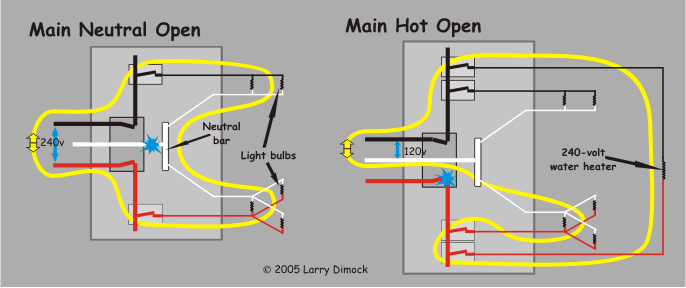Bad Main Service Wire
Strange Housewide Effects from Open Main Wire
For a discussion of an open neutral along a single circuit, see Correcting outlets. For the effects of an open neutral on two circuits that share their neutral, go to Shared neutral. To compare the abnormal conditions shown below with diagrams of normality, view these diagrams of: Your system, Power company, Main panel, Weak points, and Circuit flow.
When the main neutral becomes open at some place (blue explosion, at left in diagram), the ground rods will try to give an alternate path for 120-volt circuits through the earth, but inadequately.

So to a large degree the system of circuits is subject to 240 volts, which, depending on what is turned on out on the circuits, tries to run things by using the neutral bar as its path between its two hot main wires. Although 240 volts is more powerful, the resistances it goes through in one of its sides (black, for instance) are in series with the ones it goes through in the other (red). The common result is that some lights in the home will burn dimmer than usual and others brighter, that this can be affected by other things in the home going on or off, and that bulbs can blow out and electronics can be damaged. If the five resistances shown in the left diagram are 60 watt bulbs, they normally each burn at a 60-watt level and use 300 watts together. But with the neutral disabled, they will tend to use only 288 watts, 173 being used by the two black-circuit bulbs burning brightly (about 86 watts each) and 115 watts being used by the three red-circuit bulbs burning dimly (about 38 watts each). 240-volt items will operate normally.
Whenever a main hot becomes open somewhere (blue explosion in the right-hand diagram), the system of circuits is effectively disabled in all its 240-volt circuits and in half its 120-volt circuits (the red ones above). However, these disabled circuits can conspire to run themselves weakly, using the good main hot (black above) as follows. Any 240-volt circuit that is ready to run (is "on") will take advantage of its connection with both good and bad hots and of the fact that bad-hot 120-volt circuits have a neutral connection. In the diagram above, good black hotness will find its way through the 4500-watt water heater and from there through its red breaker and a red lighting (120-volt) breaker and its three bulbs to good neutral. The 120-volt-powered current going on this strange path will run the water heater at 29 watts and each 60-watt light bulb at 39 watts, for total of 146 watts. The other two bulbs shown run normally, being off the good black hot. The result of this kind of condition is that a water heater automatically turning on or a person turning an electric oven on will make dead lights run dimly, and the lights will go back off when the 240-volt item turns off.
Many homes built before 1985 had no single main breaker or main fuse-set. Instead there was a "sub-main breaker" or "lighting main" or a cartridge-fuse pull-out. These did not kill power to all circuits when they were turned off, but only to most 120-volt circuits in the same panel. Where this sort of arrangement (a "split-bus" panel) still exists, an extensive outage or flickering in the house can be due to a tripping or a half-compromised connection at this sub-main. When a sub-main has connection trouble internally (or one blown sub-main fuse) or with its busbar or with one of its wires that feeds to half of its 120-volt circuits, then the scenario described above regarding a "main open hot" can show itself, but only if there is a 240-volt circuit among those fed from the sub-main. A sub-main problem can be confirmed by testing whether more than one 120-volt circuit in the panel is dead while each main service wire entering the panel from outdoors still shows good hotness to ground. (The open-main-neutral problem will not occur for a sub-main section of circuits because there is no sub-main neutral, only the main neutral for the whole panel. However, if a set of breakers is located in a separate subpanel fed from the main panel, then the symptoms of either type of main open will be possible).
In my experience it is more common for a main open neutral (or hot) to occur along the power company's lines and connections than in the panel or main breaker of a home as I have depicted above. Therefore, if your home's electrical symptoms correspond to either type of main open described here, I generally recommend calling the power company first. In the case of an open main hot, reasons not to call them would be any indications that the problem is likely inside the home. For instance, if there are main or submain fuses and they have not been checked, or if some 240-volt appliance still operates completely properly (a 240-volt dryer must heat up, not just turn its drum).
"Your solutions work! I called the electric co. to come inspect the supply lines and they found the neutral connection to the house was holding on by 3 strands--they fixed and now, VOILA--no more flashing, shimmering lights. The lights still dim momentarily when the dishwasher is turned on, but they don't keep getting bright,then dim as they used to." -Dallas